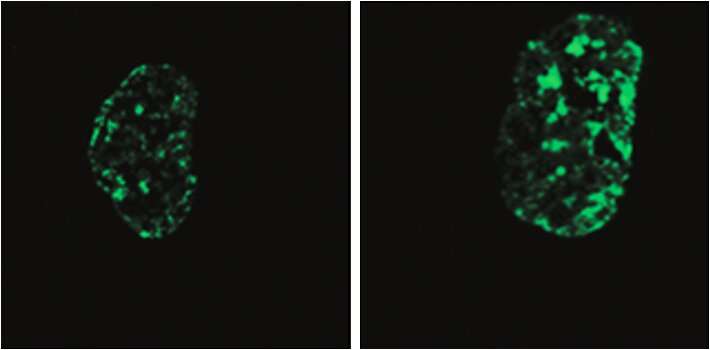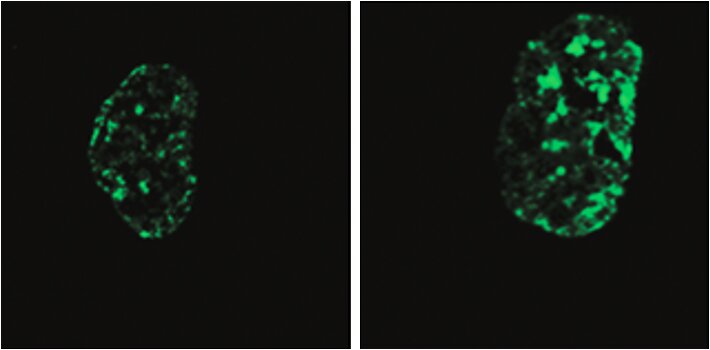
A stretch of DNA that hops around the human genome plays a role in premature aging disorders, scientists at the Salk Institute and King Abdullah University of Science and Technology (KAUST) in Saudi Arabia have discovered. In people with early aging, or progeria, RNA encoded by this mobile DNA builds up inside cells. What’s more, the scientists found that blocking this RNA reverses the disease in mice.
The findings, published in Science Translational Medicine on August 10, 2022, focus on a piece of RNA known as LINE-1.
“These findings provide new insight into progeroid syndromes and how to treat them, while also highlighting the importance of LINE-1 RNA in normal aging,” says co-corresponding author Juan Carlos Izpisua Belmonte, a professor in Salk’s Gene Expression Laboratory and director of the Altos Labs San Diego Institute of Science.
Progeroid syndromes, which include Hutchinson-Gilford progeria syndrome and Werner syndrome, cause accelerated aging in children and adolescents. Patients develop not only striking physical appearances but also symptoms and diseases typically associated with older age, such as heart disease, cataracts, type 2 diabetes, osteoporosis and cancer. There are currently no effective treatments for progeroid syndromes.
Izpisua Belmonte and his colleagues knew that one of the molecular signatures of both normal aging and progeroid syndromes is the altered overall organization of DNA. When DNA is packaged differently into the nuclei of cells, it changes which genes are accessible for the cell to use and can therefore drastically change a cell’s behavior and function.
Scientists also knew that human genomes contain hundreds of LINE-1 elements that propagate and move around the genome, as well as encode LINE-1 RNA. The function of these elements is poorly understood, but they change and multiply with age, as well as in diseases including cancer and cardiovascular disease. Izpisua Belmonte’s team wondered whether they also changed in progeroid syndromes.
“The repeat sequences like LINE-1 make up a large percentage of our genomes, but not much attention is paid to the effects of LINE-1 RNA that increase with age in the nuclei,” says co-first author Pradeep Reddy, a former Salk staff scientist and current principal scientist at Altos Labs.
The researchers studied cells derived from patients with progeroid syndromes and found that they had four to seven times more LINE-1 RNA than cells from healthy individuals. Moreover, they showed that the accumulation of LINE-1 RNA came before the major structural changes to DNA that were already associated with progeria.
The team then developed molecules that could specifically bind to LINE-1 RNA, preventing the RNA from accumulating and impacting the cells. This kind of treatment reversed the molecular signs of progeria in isolated cells and extended the life span of mice with genetic mutations that typically cause premature aging. In both cases, the expression of genes associated with cell proliferation and DNA structure increased after treatment, while the expression of genes associated with aging, inflammation and DNA damage decreased.
“Targeting LINE-1 RNA may be an effective way to treat progeroid syndromes, as well as other age-related diseases that have been connected to LINE-1, including neuropsychiatric, eye, metabolic disorders and cancers,” says Izpisua Belmonte, holder of the Roger Guillemin Chair. “Eventually, we think that this approach may lead to treatments to help extend human health span.”
Source: Read Full Article
